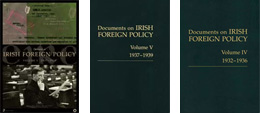No. 530 NAI DFA/10/P202
Confidential report from John J. Hearne to Seán Nunan (Dublin)
'The Korean Disaster'
Washington DC, 12 December 1950
I have the honour to refer to my telegram No. 617 of the 1st December1 and to report as follows.
It is now possible to state the facts about the disaster to United Nations forces in Korea. The chief cause of the disaster was the 'home by Christmas offensive' ordered by General MacArthur last month. It now appears that the United States Joint Chiefs of Staff were opposed to MacArthur's 'home by Christmas' offensive on the ground that if the U.N. forces, which were insufficient to engage in a full scale campaign with Chinese Communist forces, should become so engaged, disaster would follow. British intelligence gravely warned Washington at the time of Chinese Communist intentions and power. General MacArthur had sent American intelligence officers home and was relying upon his own staff intelligence which was effectively deceived as to the strength and disposition of the Chinese Communist armies. The Joint Chiefs of Staff plan was, it is understood, to concentrate and fortify U.N. forces in the narrow neck of Korea where United States air power, tanks and artillery could have contained any attack by any Chinese Communist force however formidable. It is now known that MacArthur's 'home before Christmas offensive' was decided on by him after the first Chinese Communist units had taken part in the Korean fighting.
The Joint Chiefs of Staff warned General MacArthur of the risk he might be running. They reminded him that the whole existing forces of the United States had been committed to him. They advised him of the wisdom of consolidating his forces on the narrow neck. He is stated to have replied that his projected offensive would fulfil the directives of the United Nations and asked whether the Joint Chiefs of Staff were proposing to alter or amend those directives. The U.S. Joint Chiefs of Staff did not overrule the U.N. Commander in Chief. Neither did President Truman. General MacArthur's prestige was high as a result of his previous brilliant success. And the Government of the United States was unwilling to risk the criticism that MacArthur's hand was held and the fruits of his former Korean victory thrown away by an Administration 'honeycombed with Communists' and 'soft on Communist China'.
And so came the catastrophe which brought the world to the brink of general war.
The agony of the retreat since the collapse of the offensive on the 27th November has been graphically and poignantly told in the press despatches from the field. In North East Korea twenty-five thousand casualty crushed American Marines of the First Division and other forces smashed their way out of the Chinese Communist death trap around the Changjin Reservoir and fought their way through fifty miles of 'frozen hell' to the Eastern escape port of Hungnam. It is stated to have been the bloodiest retreat in the Marine Corps history. The casualties were comparable to those at Tarawa the costliest single Marine action in World War II. By Monday night the 11th December the last of the decimated and battle scarred regiments carrying their wounded and some of their dead had reached the vicinity of Hungnam. Preparations for evacuation were complete. The last of the United Nations forces had already been pulled out of Wonsan (fifty air miles south of Hungnam) under a curtain of naval gun fire from the U.S. heavy cruiser 'St. Paul' and with the protection of the U.S. destroyers 'Hank', 'Zellers' and 'Perry'. That left Hungnam as the major escape port on the East coast.
The losses to the First Division were estimated at Marine Headquarters in Washington on the 11th December as 3,000 dead, missing, wounded and 'weather cases'. (The temperature during the march was 25o below zero).
The fearful ordeal and the heroism of the Marines in the march to Hungnam is the episode out of the tragic story of MacArthur's ill-fated adventure chiefly reported here. For it is the epic which rescues the fame of American military prowess from the tragedy of shattered leadership and the alleged disgrace of headlong flight on that fateful field.
The strategy of the Chinese Communist onslaught was classic in its simplicity. When the 'end of the war offensive' was launched on the 24th November the Chinese forces were massed in the north central part of the peninsula behind the Yalu River. MacArthur split his forces. He sent the Eighth Army (100,000 strong) along the Chinese west flank towards the River. The U.S. Tenth Corps -in a wide envelopment - marched through the mountains to the North East.
The offensive was two days under way when the Chinese plunged into the gap between the two armies in the centre of the peninsula. They ripped open the flank of the Eighth Army and flung it back in headlong retreat. The bulk of the Eighth Army escaped with most of its equipment. A large portion of the Tenth Corps was jammed in a pincer grip around the Changjin Reservoir, from which after days of threatened annihilation it battled its way east to Hungnam.
It now appears that by tomorrow the evacuation of 60,000 men will be well under way.
Meanwhile the Eighth Army is forming a new defence line in the West slightly to the north of the parallel between Yonchon and the Sea. It is threatened by another flanking movement of Chinese Communist forces massing in central Korea.
[Signed] John J. Hearne
ebooks

The Royal Irish Academy's Documents on Irish Foreign Policy series has published an eBook of confidential correspondence on the 1921 Anglo-Irish Treaty negotiations.
International Counterparts
The international network of Editors of Diplomatic Documents was founded in 1988. Delegations from different parts of the world met for the first time in London in 1989.
Read more ....
